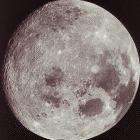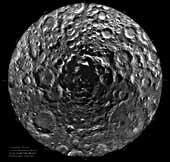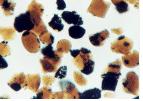- New research shows that our Moon is much
older than originally thought. It may also be far older than either the
Earth or our Sun. Our Earth is estimated to be 4.6 billion years old. However,
Moon rocks brought back by Apollo were dated at 5.3 billion years old,
and the dust upon which they rested was about one billion years older.
Who put it there and why? Can carbon dating pf moon rocks be that far off?
Perhaps, but far more evidence of the satellite's unusual history and characteristics have
been out there all along - hidden in plain sight as we shall see.
-
-

-
- http://www.solarviews.com/cap/moon/moon1.htm
- Apollo 17 Moon View (NASA)
-
-
- In a past article (April 17th 2004 -
"Our Solar System Is No Accident" [1]) I stated that the
Moon must have an artificial origin, since no natural explanation has proven
viable for it's existence. Let us explore what science might
be available to further this concept. There is a very large body of evidence
that clearly shows something strange is connected with this orbiting body.
Yet none of this data has ever been publicly explored or discussed in documentaries.
-
- We will begin with the known statistics
of our satellite: [2]
-
- Though not listed above, the Moon is
also suspected to have multiple magnetic fields. This theory was the result
of researching satellite probe data. It is important to keep this in
mind for later discussion. (The exact origin of the Earth's magnetic field
is has not been established.)
-
- For readers who may not be aware, the
Moon provides important timing functions for tides to control Earth
processes. Without tides, it is believed that the world's oceans would
have almost no life, drastically affecting the food chain for our
planet. Science already knows that tides control the behavior and life
cycles of shore and sea-based creatures. These include various species
of fish, sea turtles, penguins and many more that use tide cycles
for planting eggs. Mechanically, the Moon also acts like a huge flywheel
stabilizing the Earth's rotation. Recently the wobble in the Earth's
rotation has abruptly ceased with no explanation from the science
community as of this writing. Could the Moon have caused this to happen?
-
- MOONQUAKES
-
- Various theories have been attributed
to the Moon's origin. However, there is a silence from NASA regarding the
seismographic instrument data that Apollo left behind - Moonquakes are
taking place on our nearest neighbor. This equipment could run for many
decades, as each installation is powered by a radioactive isotope thermal
generator. Even more strange are that these events are taking place on
the far side. This was discovered more than 20 years ago. Could there be
a connection to the Earth's wobble and the presence or absence of Moonquakes?
This has yet to be proven.
-
- A planetary sciences meeting was
chaired by P R Stoddard, Department of Geology and Environmental Geosciences,
Northern Illinois University; R C Elphic, Los Alamos National Laboratory
in August of 1985. A large body of evidence was provided which showed some
very odd events taking place on the Moon. [3]
-
- Studies regarding Moonquakes and magnetic
"anomalies" (a word virtually patented by NASA for an unplanned
"event or observation") show strange things are taking place
on our silver neighbor. In the meeting, a paper was presented by Nakamura,
Y. Institute for Geophysics, University of Texas at Austin titled "Deep
Moonquakes: Remaining Problems."
- Here is an extract of their research
paper summary. They state the center of the Moon may be hollow. My explanation
of scientific terms are enclosed ini [ ]:
-
- "We have recently reexamined more
than 9000 previously unidentified seismic events catalogued during the
Apollo landing missions and positively identified for the first time about
30 deep Moonquake nests on the far side of the Moon. Although only a few
of them are currently locatable, the relative arrival times among stations
for the rest and presence or absence of seismic signals at particular stations
suggest that either:
-
- (a) The region within about 40 degrees
of the antipode [a point on the opposite side] is aseismic [a place
where no Moonquakes have ever been observed.]
-
- (b) Or the deep interior of the
Moon severely attenuates or deflects seismic waves.
- In (b) above, this could make sense if
the deep interior is hollow. Aside from the obvious question of how to
distinguish between such hypothetical models, this effort raised several
more general questions concerning the use of deep Moonquake signals to
infer the structure and dynamics of the deep interior of the Moon... "
-
- MAGNETIC FIELDS OF UNKNOWN ORIGIN
-
- Another paper titled "Correlations
Between Magnetic Anomalies and Surface Geology Antipodal to Lunar Impact
Basins" was also presented by Richmond, N C, Institute of Geophysics
and Planetary Physics, Scripps Institution of Oceanography, University
of California and Hood, L L, Lunar and Planetary Laboratory, University
of Arizona, Tucson. The summary for this paper states "Previous work
has shown that the strongest concentrations of lunar crustal magnetic anomalies
[magnetized areas] are located antipodal [opposite sides of the Moon] to
four large, similarly aged impact basins (Orientale, which is furrowed
and pitted terrane and Serenitatis, Imbrium which is material of grooves
and mounds and Crisium).
-
- Only these areas have been selected due
to:
-
- a) Limited Lunar Prospector magnetometer
data coverage of the area antipodal to Serenitatis [name of a crater] and
- b) The location of the Crisium antipode,
which is dominated by ejecta deposits from the more recent Orientale impact.
-
- Here, we report results of a correlation
study between magnetic anomaly clusters and geology in areas antipodal
to Imbrium and Orientale...This is supported by an observed lack of demagnetisation
associated with the 61 km Copernican-aged O'Day crater at the edge of Mare
Ingenii, which suggests a deep source for the anomalies [unexplainable
magnetized areas.] Possible source materials and the origin of the magnetisation
will be discussed at the conference."
-
- Put in simplified terms, this paper showed
that magnetized areas were found on the OPPOSITE side of the Moon from large
craters. The data was obtained from the orbiting Lunar Prospector satellite.
Yet in the absence of an overall planetary magnetic field (magnetosphere)
no one can determine how this magnetization could happen. Perhaps a meteorite
hitting the Moon is like striking an iron rod, which if done just right
can align the molecules to form a magnet. The problem here is
that the area the researchers are talking about is 2,000 miles away from
the crater - on the opposite side of the Moon!
- Molten magnetite rock on Earth is well
known to have molecules aligned to the Earth's magnetic field while cooling.
This pattern is permanently retained and has helped scientists to determine
when and how often the Earth's magnetic poles have flipped. Unfortunately,
no magnetosphere encompassing the entire Moonhas been detected as
of this writing.
- Among the other papers at the conference
was yet another titled "Lunar magnetic anomalies in the
solar wind: Possible existence of mini-magnetosphere" written by Kurata,
M of the Tokyo Institute of Technology, Tsunakawa, H also of
the Tokyo Institute of Technology, and Saito, Y of the The Institute
of Space and Astronautical Science.
-
-
- Here is an extract of that paper's summary:
-
-
- "It has been suggested that lunar
magnetic anomaly fields are interacted with the solar wind plasma to form
the mini-magnetosphere on the lunar surface...Lin et al.(1998) pointed
out that a mini-magnetosphere was formed in the solar wind downstream of
the strong magnetic anomaly in Imbrium antipode region... If the mini-magnetosphere
exists on the lunar surface deflects solar wind particles, its role of
barrier could produce a high-albedo region around the magnetic anomaly.
In this study, we mainly investigate magnetic anomaly fields in the solar
wind at low-altitude (15-40 km) with a data of level 1.
-
-
- We detected lunar magnetic anomalies
after preprocessing of the level 1 data... In the present study, magnetic
anomalies were mapped from the data sets in the tail lobe, the Moon wake
and the solar wind, and were compared with each other... Its contour pattern
of magnetic field intensities in the tail lobe or the wake is almost symmetrical
with respect to the north-south line. However, such symmetry [of the magnetic
field] is obviously distorted in the solar wind to show some elongation
toward the downstream of the solar wind. Also, the form of distortion [of
the magnetic field] seems to be changed when the solar wind conditions
(dynamic pressure, the angle of incidence, and so on) are different. These
results may support existence of the mini-magnetosphere in Reiner Gamma
region. We will discuss the possible mini-magnetosphere comparing the LP
MAG data with the ACE data of the solar wind."
-
-
- The above summary tells us that a solar
wind appears be affected by a mini-magnetosphere! Yet other researchers claim
this field cannot exist! Perhaps the true nature and characteristics of
the solar wind are not fully understood. Many other papers and studies
exist that use data collected by NASA instrumentation which we cannot cover
here. The general public is completely unaware of most of these papers,
as scientists tend to stay within their own disciplines (and circles of
friends) for peer review.
-
-
- RESONANCE
-
-
- When the spent Lunar Landers were commanded
to crash into the Moon from orbit, the Moon rang for an unexpected period
of time. The first time was on November 20, 1969 and it used the lander
for the Apollo 12. The seismographs left behind caused the Moon to
ring for more than an hour. Apollo thirteen's third stage impact on the
Moon was even more incredible. Reverberations lasted for three hours
and twenty minutes, down to an estimated depth of twenty-five miles.
This ringing seems to suggest the Moon may have no core at all.
-
-
- STRANGE MATERIALS AND SHAPES
-
-

-
- http://www.solarviews.com/cap/moon/clmsouth.htm
- Lunar South Pole (NASA)
-
-
- This mosaic is composed of 1,500 Clementine
images of the south polar region of the Moon. The top half of the mosaic
faces Earth. One can easily see a counter-clockwise, swirl-like pattern
of craters. Is this pattern the result of random impacts of over eons
of time or just an illusion?
-
- The lunar crust is also much harder
than previously thought. Astronauts had difficulty when drilling for samples
on the Lunar surface (maria.) The maria is composed primarily illeminite,
a mineral containing large amounts of titanium which is an extremely hard
metal, and quickly wears out the best machine tool bits. Titanium is also
very light in weight, like aluminum. Uranium 236 and neptunium 237
(elements not normally found on Earth) were discovered in lunar rocks.
How did these elements get there? If one were to argue they were formed
on the Moon, then how did this happen?
-
-
-

-
-
- http://www.solarviews.com/cap/moon/moondust.htm
- Orange colored glass spheres and other fragments
from Apollo 17, which is actually dust under high magnification.
-
-
- The particles shown range from 20 to
45 microns, and was brought back from the Taurus-Littrow landing site.
Scientist-Astronaut Harrison J. Schmitt discovered the dusty orange soil
at Shorty Crater. The orange particles are mixed with black grains of other
material, and are about the same size as the particles that compose silt
on Earth. Chemical analysis of the orange soil material revealed it
is similar to samples from the Apollo 11 landing area (Sea of Tranquility)
site several hundred miles to the southwest. Like Apollo 11 samples, Apollo
17 samples are also rich in titanium (8%) and iron oxide
(22%). Unlike the Apollo 11 samples this orange soil is also unexplainably
rich in zinc. The orange soil is probably of volcanic origin and not the
product of meteorite impact. (NASA)
- The question is - could volcanic
action have existed on the Moon? It remains unproven if the Moon ever
had volcanoes in the ancient past.
-
- ORBITAL ODDITY
-
- Ours is the only Moon in the solar
system with a stationary, circular orbit which is almost perfectly circular.
The Moon,s center of gravity is approximately 6000 feet closer to the Earth
than its geometric center. This should make the Moon wobble but it
does not. The resultant bulge is located on the far side of the Moon, opposite
the side facing our Earth. It begs to ask the question - who or what put
the Moon into correct orbit? Who or what established the perfect velocity?
This is clearly no accident.
-
- POSSIBLE FIRST SIGHTING OF THE MOON BY
MAN AND FLASHES OF LIGHT
- One of the most fascinating of the lunar
observations are flashes of light. Ancient authors such as Aristotle and
Plutarch wrote about a group called the Proselenes of Greece. This group
claims to have existed before the Moon was in orbit. Heiroglyphs found
near the city of Tiahuanaco, Bolivia record the Moon entering into orbit
about 11,500 to 13,000 years ago.
-
-
- Other historians and writers such as
Aristarchus, Plato, Eratosthenes, Biela, Rabbi Levi, and Posidonius all
reported anomalous lights on the Moon. One year before the first Apollo
landing, NASA reported that more than 570 flashes were observed on
the Moon over more than 400 years, from 1540 to 1967.
-
-
- On July 29, 1953, John J. O,Neill observed
a 12-mile-long bridge straddling the crater Mare Crisium. In August, British
astronomer Dr. H.P. Wilkens verified its presence, "It looks artificial.
It,s almost incredible that such a thing could have been formed in the
first instance, or if it was formed, could have lasted during the ages
in which the Moon has been in existence.
-
-
- An obelisk-shaped object that towers
1 miles from the Ukert area of the Moon,s surface, was discovered by Orbiter
3 in 1968. Dr. Bruce Cornet, who studied the amazing photographs, stated,
"No known natural process can explain such a structure."
- One of the most curious features ever
photographed on the Lunar surface (Lunar Orbiter photograph III-84M) is
an amazing spire that rises more than 5 miles from the Sinus Medii region
of the lunar surface.
-
-
- The Obelisks: Lunar Orbiter II took several
photographs in November 1966 that showed several obelisks, one of which
was more than 150 feet tall. ". . . the spires were arranged in precisely
the same was as the apices of the three great pyramids." [4]
-
-
- SUMMARY
-
- Almost everything we look at with regard
to the Moon does not fit any known natural method of formation. Either
our neighbor is artificial, or it is not. Scientists everywhere continue
to find oddities that strongly indicate artificial origin. If it is artificial,
what does this say about our Earth's origins? Could life have been sustained
on our Earth if the Moon was not in orbit before 13,500 years ago? Everything
we know about the mechanism and cycle of life in our oceans indicates
it could not. To form an object the size of our Moon requires physics,
engineering and materials manufacturing technology far beyond anything
we can imagine today. Are the depressionas and deep holes we casually
label as craters without giving it a second thought - actually
craters?
-
- Perhaps one day the Moon's creators will
land on Earth to see what our progress is. Then they will takeoff again
to go dust off their creation with a wave of their hand
over a control panel? That's all fine and dandy - as long as they don't
kidnap the "man in the Moon."
- Summer nights would never be the same
again without him...
-
- Ted Twietmeyer
-
- Inventor, engineer and frequent rense.com
contributor, Mr. Twietmeyer is author of "What NASA Isn't Telling
You About Mars" which is available at
- www.data4science.net/book
-
- REFERENCES
- [1] "Our Solar System Is No Accident"
-
- http://www.rense.com/general51/solar.htm
- [2] Moon statistics -
- http://www.solarviews.com/eng/moon.htm#stats
- [3] Moon conference details -
- http://www.agu.org/meetings/fm04/fm04-sessions/fm04_P23A.html
- [4] Strange Moon Facts -
- http://www.informantnews.com/starshipgamma/lunar/moon2.html
|